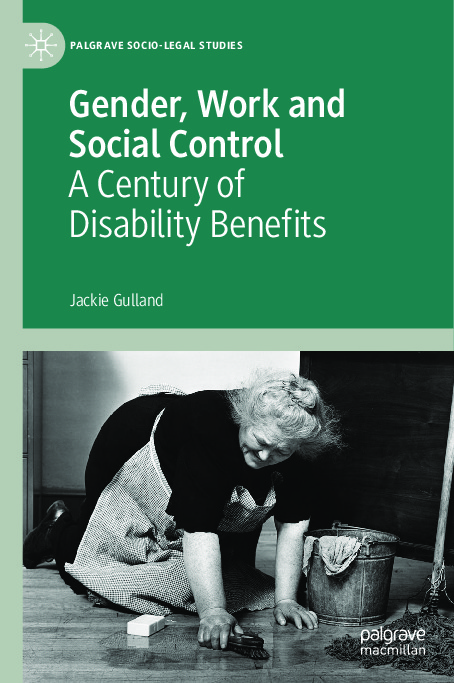File #2592: "2019_Book_GenderWorkAndSocialControl.pdf"
Text
1|Acknowledgements|7
1|Contents|10
1|Abbreviations and Acronyms|12
1|Table of Cases|13
1|1 Introduction|16
2|Incapacity for Work|16
2|Sweeping the Path: The Case of Mrs E|17
2|Disability|20
2|Gender|23
2|Work|25
2|Social Control|27
2|Sources for the Book|29
2|Structure of the Book|31
2|References|32
1|2 From National Insurance in 1911 to Employment and Support Allowance|38
2|Introduction|38
2|The National Insurance Act 1911|38
2|Appeals Under the National Insurance Act 1911|40
2|The National Insurance Act 1946 and the Post-war Welfare State|41
2|The Creation of New Benefits for Disabled People in the 1970s|42
2|Incapacity Benefit and a New Medical Test|42
2|Employment and Support Allowance|43
2|References|44
1|3 Only Those Unconscious or Asleep: Definitions of Incapacity for Work|47
2|Introduction|47
2|Statutory Definitions|47
2|Sickness, Disability and the Six-Month Guideline|49
2|Control Measures for Short-Term Claims|53
2|The Relevance of Social Barriers in Defining Capacity for Work|58
2|Incapacity Benefit and the “Objective Test”|59
2|Employment and Support Allowance and Increasing Conditionality|61
2|Conclusions|63
2|References|64
1|4 The Necessity of Questioning the Doctor: Medical and Other Evidence|67
2|Introduction|67
2|The Medical Certificate|70
2|Medical Referees and the Regional Medical Service|71
2|Sick Visitors|79
2|Sick Visitors After 1948|80
2|Claimant and Other Evidence|81
2|Incapacity Benefit and the Move to Points-Based Assessment|85
2|Employment and Support Allowance|86
2|Conclusions|89
2|References|90
1|5 Bridge Toll Attendants and Driving a Quiet Horse: The Labour Market and Structural Barriers to Work|93
2|Introduction|93
2|The Relationship Between Unemployment and Incapacity|95
2|Statutes and Case Law|96
2|Attachment to the Labour Market|98
2|Alternative Work|103
2|Attachment to the Labour Market After 1948|107
2|Using the Social Model of Disability to Understand Incapacity for Work|110
2|Conclusions|119
2|References|119
1|6 Fit for the Ordinary Work of the Home: Women and Domestic Work|122
2|Introduction|122
2|Legislation and Case Law|123
2|Housework in the Interwar Sickness Benefits Scheme|124
2|Married Women and Housework After 1948|132
2|The Pinnacle of Household Duties—The Case of HNCIP|140
2|Domestic Work in the 1990s and Today|143
2|Conclusions: Housework as a Form of Conditionality or as Evidence of Capacity for Work|144
2|References|145
1|7 Not Incapable of Playing Bingo: Ideas About “Work” in Incapacity Benefits|147
2|Introduction|147
2|Legislation and Case Law|148
2|Paid Work|149
2|Unpaid Work|155
2|Permitted Work|158
2|Work as an Individual Activity|159
2|The Opposite of Work|163
2|Conclusions|164
2|References|165
1|8 Immoral Conduct: Moral Regulation in Incapacity Benefits|167
2|Introduction|167
2|Sanctions|168
2|Misconduct Before a Claim|170
2|Behaviour During Sickness Rules|182
2|Moral Regulation After 1948|185
2|ESA and Moral Conditionality Today|189
2|Conclusions|191
2|References|191
1|9 Unacceptable Snooping: Sick Visitors and Other Methods of Surveillance|194
2|Introduction|194
2|Sick Visitors as Detectives|195
2|Local Knowledge and Acting on Tip-Offs|200
2|Sick Visiting in the 1930s|204
2|The 1940s and the Transition to a State System|205
2|Professionalisation of Sick Visitors and Training in the 1950s|206
2|Medical Surveillance|209
2|Conclusions|211
2|References|212
1|10 Conclusion|214
2|References|219
1|Appendix Sources and Methods|221
1|Archives|221
1|The National Archives, London|221
1|London Metropolitan Archive, London|222
1|National Records of Scotland, Edinburgh|222
1|Prudential Assurance Company Archive, London|222
1|Public Record Office of Northern Ireland, Belfast (PRONI)|223
1|Working Class Movement Library, Salford (WCML)|223
1|British Newspaper Archive (Online)|223
1|Sources for Appeal Cases|223
1|Published Appeal Cases|223
1|Archived Appeal Cases|224
1|Analysis, Ethics and Anonymity|224
1|Reference|226
1|References|227
1|Index|240
1|Contents|10
1|Abbreviations and Acronyms|12
1|Table of Cases|13
1|1 Introduction|16
2|Incapacity for Work|16
2|Sweeping the Path: The Case of Mrs E|17
2|Disability|20
2|Gender|23
2|Work|25
2|Social Control|27
2|Sources for the Book|29
2|Structure of the Book|31
2|References|32
1|2 From National Insurance in 1911 to Employment and Support Allowance|38
2|Introduction|38
2|The National Insurance Act 1911|38
2|Appeals Under the National Insurance Act 1911|40
2|The National Insurance Act 1946 and the Post-war Welfare State|41
2|The Creation of New Benefits for Disabled People in the 1970s|42
2|Incapacity Benefit and a New Medical Test|42
2|Employment and Support Allowance|43
2|References|44
1|3 Only Those Unconscious or Asleep: Definitions of Incapacity for Work|47
2|Introduction|47
2|Statutory Definitions|47
2|Sickness, Disability and the Six-Month Guideline|49
2|Control Measures for Short-Term Claims|53
2|The Relevance of Social Barriers in Defining Capacity for Work|58
2|Incapacity Benefit and the “Objective Test”|59
2|Employment and Support Allowance and Increasing Conditionality|61
2|Conclusions|63
2|References|64
1|4 The Necessity of Questioning the Doctor: Medical and Other Evidence|67
2|Introduction|67
2|The Medical Certificate|70
2|Medical Referees and the Regional Medical Service|71
2|Sick Visitors|79
2|Sick Visitors After 1948|80
2|Claimant and Other Evidence|81
2|Incapacity Benefit and the Move to Points-Based Assessment|85
2|Employment and Support Allowance|86
2|Conclusions|89
2|References|90
1|5 Bridge Toll Attendants and Driving a Quiet Horse: The Labour Market and Structural Barriers to Work|93
2|Introduction|93
2|The Relationship Between Unemployment and Incapacity|95
2|Statutes and Case Law|96
2|Attachment to the Labour Market|98
2|Alternative Work|103
2|Attachment to the Labour Market After 1948|107
2|Using the Social Model of Disability to Understand Incapacity for Work|110
2|Conclusions|119
2|References|119
1|6 Fit for the Ordinary Work of the Home: Women and Domestic Work|122
2|Introduction|122
2|Legislation and Case Law|123
2|Housework in the Interwar Sickness Benefits Scheme|124
2|Married Women and Housework After 1948|132
2|The Pinnacle of Household Duties—The Case of HNCIP|140
2|Domestic Work in the 1990s and Today|143
2|Conclusions: Housework as a Form of Conditionality or as Evidence of Capacity for Work|144
2|References|145
1|7 Not Incapable of Playing Bingo: Ideas About “Work” in Incapacity Benefits|147
2|Introduction|147
2|Legislation and Case Law|148
2|Paid Work|149
2|Unpaid Work|155
2|Permitted Work|158
2|Work as an Individual Activity|159
2|The Opposite of Work|163
2|Conclusions|164
2|References|165
1|8 Immoral Conduct: Moral Regulation in Incapacity Benefits|167
2|Introduction|167
2|Sanctions|168
2|Misconduct Before a Claim|170
2|Behaviour During Sickness Rules|182
2|Moral Regulation After 1948|185
2|ESA and Moral Conditionality Today|189
2|Conclusions|191
2|References|191
1|9 Unacceptable Snooping: Sick Visitors and Other Methods of Surveillance|194
2|Introduction|194
2|Sick Visitors as Detectives|195
2|Local Knowledge and Acting on Tip-Offs|200
2|Sick Visiting in the 1930s|204
2|The 1940s and the Transition to a State System|205
2|Professionalisation of Sick Visitors and Training in the 1950s|206
2|Medical Surveillance|209
2|Conclusions|211
2|References|212
1|10 Conclusion|214
2|References|219
1|Appendix Sources and Methods|221
1|Archives|221
1|The National Archives, London|221
1|London Metropolitan Archive, London|222
1|National Records of Scotland, Edinburgh|222
1|Prudential Assurance Company Archive, London|222
1|Public Record Office of Northern Ireland, Belfast (PRONI)|223
1|Working Class Movement Library, Salford (WCML)|223
1|British Newspaper Archive (Online)|223
1|Sources for Appeal Cases|223
1|Published Appeal Cases|223
1|Archived Appeal Cases|224
1|Analysis, Ethics and Anonymity|224
1|Reference|226
1|References|227
1|Index|240

